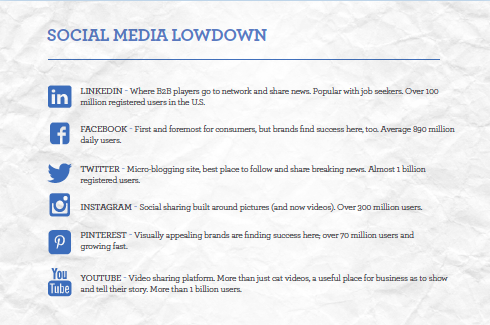In a recent survey from Maxus, 70 percent of business people said B2B brands don’t do a good enough job of communicating with them online.
And 86 percent were keen to see company news and content from suppliers on social media, as long as it was relevant. In other words, business audiences want you to communicate with them.
Many B2B marketers feel a level of frustration with their social efforts, particularly when they read about the successes that consumer companies are having in the social space. The fact is, social media marketing can be very effective for B2B companies, but success looks different than it does for consumer companies.
Social media can be an extremely effective tool for B2B marketers because it can help to:
- Increase brand awareness
- Humanize your company
- Establish your company as a thought leader
- Connect with prospects, clients and industry influencers
- Nurture leads
- Increase lead-conversion rate
The biggest complaint we hear has to do with low numbers of fans and followers. With B2B social media marketing, you have to understand that your universe will be smaller. And that’s not a bad thing. Focus on the key audiences that matter to you. The point isn’t to create a “Gangnam Style” viral effect or get millions of views. If your efforts help to create a lead, nurture prospects, strengthen a relationship, shorten the sales cycle or build your reputation, it’s worth way more than getting a bucketful of views.
Here are some best practices to help strengthen your social efforts:
Align content to your sales funnel, but don’t be self-centered.
Think about relevant content at every stage of the purchase process. Help bridge buyer pain points and address their decision-making criteria. Things like calculators, comparison guides and case studies can be very effective. Use the 80/20 rule to avoid being self-centered. 20 percent of your daily content should be related to your business, while the other 80 percent should be broader industry news and engagement. By sharing content other than your own, your followers will know they can rely on you to be a resource for the latest in the industry.
Find your audience.
Of course, you should follow and engage with current and potential customers, but also look broader to find the key influencers in your industry. Tools like Followerwonk, SocMetrics and WeFollow can help pinpoint influencers around particular subjects. These people can be fundamental in helping spread awareness of your brand.
Engage.
Social media is a dialog, not a monologue. So respond to questions and comments directed toward you through @ replies and comments. Use tools that allow you to monitor relevant conversations and seek opportunities to join in. Hashtags are another great way to be a part of the conversation; they give you a sense of what people are talking about and reveal questions you may be able to answer.
Analyze and audit.
Analyze how social is contributing to your bottom line. Set up your analytics to evaluate the effect of social on your website traffic – and even sales. When sharing links to your website content, tag them; this will enable you to see what channels and social campaigns are getting people to click. Tools like Buffer and Followerwonk will let you know what content is doing particularly well, or how engaging you’ve been. From there, you can tweak your program as needed.




